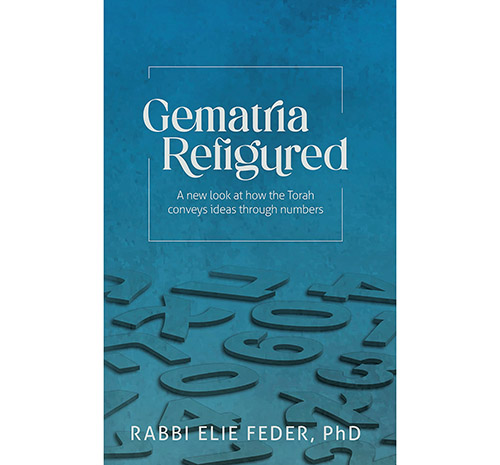
Reviewing: “Gematria Refigured: A New Look at How the Torah Conveys Ideas Through Numbers” by Rabbi Elie Feder, PhD. Mosaica Press. 2022. English. Hardcover. 188 pages. ISBN-13: 978-1957579252
Many seforim come out on varying topics and many disciplines every week. Some bring new ideas, some present new translations, others are reprints of long-lost or forgotten manuscripts. However, it is rare for a new sefer to come out that opens up an entire area in the field of Torah study. “Gematria Refigured” by Rabbi Dr. Elie Feder does just that.
The hidden and enigmatic area of gematria is lost to, and often ridiculed by, the multitude. I will echo the words of the Minchas Asher, Rav Asher Weiss, who said that, “This book has paved a path to understand the hidden riddle [of gematria].” I will merely provide a review that describes how it does so.
The author, aside from having Yoreh Yoreh and Yadin Yadin, has a PhD in mathematics. However, that should not turn away the reader! This book is not written as a calculus textbook for some college course by this college professor and yeshiva rebbi. Rather, it is written as a story. The author takes you on a journey. On his journey.
Although you can learn each chapter individually to understand each beautiful insight he builds upon to explain the gematria, by reading the chapters in order, the reader goes through the author’s experiences and frustrations, and recognizes that we often share the same experiences. Rabbi Feder points out that he had initial discomfort with gematria because in his experience it seemed to merely connect two random, unrelated topics, and cursorily connect them. He said that, “While this method is not always applied in such a superficial manner, it often is. As a naive youngster, my cynicism toward gematria was directed at these types of uninspiring applications. The question that bothered me was whether we can actually learn anything from gematria in this manner.”
The author echoes a sentiment that many readers experience when they encounter gematrias. They find tenuous connections, flimsy patchwork to complete connections, and very strange partnerships made between topics. However, as the stalwart talmid chacham that Rabbi Feder is, he “knew in the back of my mind that gematria was not invented last year but was part of our mesorah. I was well aware of the many Rashis and Gemaras that utilized gematria…I was convinced that Chazal were not superficial thinkers and, therefore, must have had something more—something deeper—in mind.”
Rabbi Feder then quotes from the authorities of our mesorah to define this concept found from our mesorah. He presents the different approaches as they are developed by our authorities and provides the reader an understanding including what the ibn Ezra and Ramban are telling us about gematria. The author then provides practical application in showing us how to learn gematrias, offering the reader vital tools and a cogent theory to be able to decipher gematrias on their own.
In each chapter a gematria is presented, and the author asks penetrating questions that should bother the learner when confronting the rabbinic statement. For instance, Rabbi Feder presents the gematria that Rashi quotes that Hashem blessed Avraham “bakol” with everything, which has the same numerical value as “ben” or a son. The author asks what prompted the rabbis to present this answer, which takes an answer out of a pshat understanding. Since being blessed with everything would include having a son and many other things, why would the gematria limit “everything” to just “one thing”?
Rabbi Feder takes up famous gematrias like the one where we learn there are 613 commandments, based on the word “Torah” adding up to 611, and then you add the two that were mentioned directly to the people of Israel from Hashem, not through Moshe, and the patchwork that goes into play in this math problem. Rabbi Feder teaches the reader how this patchwork actually comes to highlight an important insight that the rabbis are teaching us that would be lost without this method.
He covers the famous problem of the gematria in which Rashi tells us “tzitzis” totals 600 combined with the five knots and the eight strings, which totals 613 commandments. The Ramban has a powerful question, where he points out that the Torah doesn’t spell “tzitzis” in a full manner, so the word only adds up to 590, plus the five knots are not from the Torah level and the eight strings are not agreed upon by everybody. He then goes on to cull important ideas and reveal fundamental lessons that Chazal are teaching us in general and that they also reveal about each verse.
The author takes the reader on his journey through his recognition of an understanding and a resulting love of gematria. “As a rabbi, I was perplexed how the mesorah and people as great as Chazal toiled in what I naively perceived to be simplistic numerical manipulations. I have since come to appreciate the ingenuity of the mesorah and Chazal in their clever usage of gematria.” Rabbi Feder provides an overall theory for gematrias in general and elicits his mastery of many areas of Torah knowledge to apply said theory to plumb the depths of the allusions that the bearers of the mesorah provide us with. I leave you to read the book to uncover this theory and unravel the mysteries to figure out the gematrias.
Rabbi Eliezer Barany is an editor and serves as a high school rebbi at Posnack Jewish Day School in South Florida.













